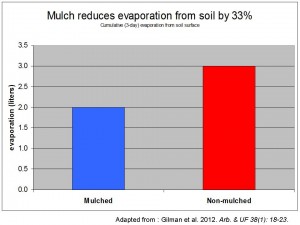I was just in Fargo for the North Dakota Urban and Community Forestry Association conference – our pantywaist -12 deg. F wasn’t cold enough – I wanted to experience some real winter. Dr. John Ball from South Dakota State University, whom I enjoy listening to, was also on the program. As an aside, if you are ever invited to speak at the same conference as John, DO NOT allow yourself to be scheduled after him. He is hilarious and you will sound like a boring moron by comparison. John is an excellent and entertaining speaker and I usually agree with 90+ % of what he says. In this case he was talking about mulch – a subject near and dear to my heart – and lead off by mentioning the recent study by Gilman et al. (2012) as a reason why we should be concerned about possible negative impacts of mulch.
Oh boy. Let’s go through this and see what the paper does and doesn’t say about mulch.
The study was done in collaboration with Richard Beeson, who is widely known for his work using weighing lysimeters to estimate water use by container-grown trees and shrubs. In this case lysimeters were used to measure water lost from containers filled with soil or container media (60% pine bark : 30 % peat: 10% sand) and then covered with pine bark mulch or left uncovered. The containers were watered and allowed to drain. Water loss due to evaporation (there were no trees in the containers) was measured for three days. For the first day after watering there was more evaporation from the containers filled with container substrate that were mulched than the containers that were not mulched. However, if you add up the evaporation over the entire 3 days there is no difference between mulched and non-mulched containers. This is not too surprising since the mulch and container media were largely the same thing – pine bark.
Now here’s the important part. If you look at evaporation for the soil-filled containers – which are the ones we really care about from a landscape perspective – total evaporation was 3L for non-mulched containers versus 2L for mulched. In other words, there was much greater water loss from soil when the pots where not mulched. A much better title for the article would have been, “Mulch reduces evaporation from soil by 33%”!
It’s easy to nit-pick articles but this isn’t pit-picking. There is only one table in this article and they got it wrong. For whatever reason people are prone to hysteria when it comes to tree care and I can already see this morphing into “Oh my God! Did you hear? Ed Gilman says if you mulch a tree you’re going to kill it!” A misinterpreted 3-day study has everyone criticizing mulch while ignoring a vast body of long-term studies.



